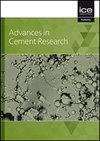换渣低钙粉煤灰碱活性粘结剂的生产与评价
IF 1.3
4区 工程技术
Q3 CONSTRUCTION & BUILDING TECHNOLOGY
引用次数: 0
摘要
配制碱活化粘合剂需要清楚地了解活化剂浓度和原料组成对产品形成和强度增加的作用。评价了以30和50质量%的炉渣置换的低钙粉煤灰粘结剂的碱性活化。使用不同NaOH摩尔浓度的活化溶液来评估粘合剂的反应性和抗压强度增益。增加NaOH摩尔浓度在活化的粘合剂中产生更高的抗压强度。在活化的粘合剂中形成的主要反应产物是具有铝取代的硅酸钙水合物(C-(a)-S-H)。随着NaOH摩尔浓度的增加,C-(A)-S-H含量增加,孔隙率降低。矿渣有助于粘结剂的早期反应性和初始强度的发展,而粉煤灰通过富集二氧化硅的C-(A)-S-H有助于后期强度。虽然增加NaOH摩尔浓度会增加早期反应性,但Na不会直接促进反应产物的形成。碱性活化剂中的Na不与C-(A)-S-H化学结合,可以通过在水中浸出来去除。随着NaOH摩尔浓度的增加,碱度的增加增强了低钙粉煤灰对C-(A)-S-H二氧化硅富集度的贡献。本文章由计算机程序翻译,如有差异,请以英文原文为准。
Production and evaluation of alkali-activated binders of low-calcium fly ash with slag replacement
Formulating alkali-activated binders requires a clear understanding of the role of activator concentration and source material composition on product formation and strength gain. Alkaline-activation of a low-calcium fly ash binder with slag replacement at 30 and 50% by mass is evaluated. The reactivity of the binder and the compressive strength gain are evaluated using activating solutions of different NaOH molarities. Increasing the NaOH molarity produces a higher compressive strength in the activated binder. The primary reaction product formed in the activated binder is a calcium silicate hydrate with aluminium substitution (C-(A)-S-H). There is an increase in the C-(A)-S-H content, and a reduction in the porosity, with an increase in NaOH molarity. Slag contributes to early reactivity in the binder and the initial strength development while fly ash contributes to later age strength by silica enrichment of C-(A)-S-H. While increasing the NaOH molarity produces an increase in the early reactivity, the Na does not directly contribute to the reaction product formation. The Na from alkaline activator is not chemically bound to the C-(A)-S-H and can be removed by leaching in water. The increasing basicity with NaOH molarity enhances the contribution of low-calcium fly ash leading to higher silica enrichment of C-(A)-S-H.
求助全文
通过发布文献求助,成功后即可免费获取论文全文。
去求助
来源期刊

Advances in Cement Research
工程技术-材料科学:综合
CiteScore
3.70
自引率
5.00%
发文量
56
审稿时长
3.2 months
期刊介绍:
Advances in Cement Research highlights the scientific ideas and innovations within the cutting-edge cement manufacture industry. It is a global journal with a scope encompassing cement manufacture and materials, properties and durability of cementitious materials and systems, hydration, interaction of cement with other materials, analysis and testing, special cements and applications.
 求助内容:
求助内容: 应助结果提醒方式:
应助结果提醒方式:


